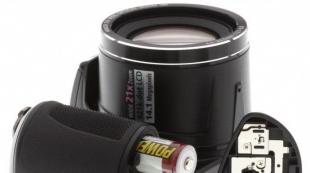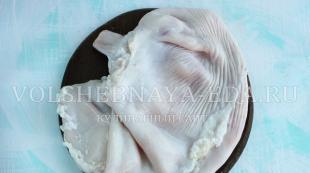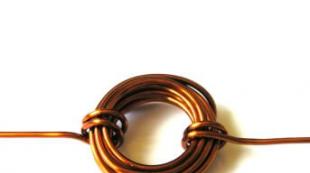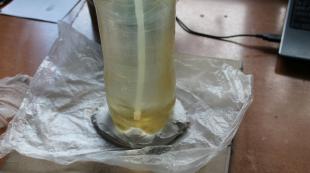How to make a beautiful bouquet with your own hands. Floristry for beginners step by step
If you want to create a wedding bouquet yourself, then choose any of the two suggested methods. Learn about the language of plants, the principles of composing flower compositions.
The content of the article:
Flowers are amazing natural creations. One glance at them is sometimes enough to cheer yourself up. Rooms are decorated with flowers, tables are decorated during a significant event, presented as a sign of respect and love. They are bred at home, in the country. It's nice and easy to go out into nature in summer to admire the flowering of charming plants and plunge into their aroma.
plant language

If you know how to make a bouquet, then you can become a florist at least in your family and delight friends and loved ones with such picturesque gifts. A different color, different groups of plants are able to say for a person what he did not dare to tell.
Before you arrange a bouquet, learn about the language of flowers:
- Anyone who wants to express his admiration, let him present a bouquet of lilies and camellias.
- Mimosa will hint that the donor carefully hides his feelings for you.
- If you were handed a bouquet of white irises or pink or red roses, tulips, these plants speak eloquently of love.
- Also, red and white roses can say in the language of flowers that you are the soulmate of the giver (at least he or she thinks so).
- But it is better not to get yellow carnations, as these flowers will report the unpleasant news that they have stopped loving you.
- Carnations of a different color, chrysanthemums and hyacinths are awarded as a sign of respect.
- Be sure someone is fascinated by you if they presented a bouquet of lavender, violets or burgundy roses.
- If a bouquet of orchids and chrysanthemums is made up, it means that the donor is pleased to meet you.
- And one or more branches of lilac will remind you or let you know that you were the first love of the giver.
How to make a bouquet

If you want to assemble a spring arrangement of fresh flowers, then use plants of no more than three colors. Of course, the range of shades should be combined with each other.
For example, if you take a purple lilac and want to add tulips to the composition, then they should not be red or yellow. In this case, it will not be possible to achieve tenderness. To make it, include white, light pink or pale lilac tulips in the bouquet.
You can add other flowers, such as hyacinths, but they should also be of a delicate color and blend in with the rest of the plants.
Speaking about how to make bouquets, it is important to note that one can have several names of plants. A composition that uses gerberas, red tulips, gypsophila, and chrysanthemums looks beautiful.
At the same time, it is important to observe the color palette and the principle of composing a bouquet:
- Arrange the lightest or smallest flowers along its edges, but they should not hang down. Gypsophila will look great here. Put dark and bright plants in the center of the composition. Falling and curly are placed near the stems of the primary flowers.
- Don't use a lot of greens. It is enough to add a carved palm leaf or a fluffy sprig of asparagus. At the same time, greens should not rise above the flowers, unlike cereals.
- Drawing up bouquets also includes the knowledge that the flowers in such a composition should not be located close to each other, let them look freely.
- When creating a composition, consider its concept. When you make a field bouquet, do not combine "complex" and "simple" flowers in it. Indeed, among lilies of the valley, daffodils, small daisies, for example, an exotic anthurium, an orchid will look ridiculous. The charm and elegance of a "simple" bouquet of small daisies, lilies of the valley will be emphasized by solidago, iris and other flowers, sustained in the same color range.
- Use plants that are in different stages of dissolution: let there be strong buds here, slightly blossomed and fully opened.
To cut flowers do not wilt longer, put a sprig of geranium or arborvitae to them. At least every other day, cut the stems, rinse them and change the water in the vase to fresh.
Examples of creating compositions from fresh flowers

If you do not know how to create a bouquet for a teacher, the one below will be ideal option. Indeed, in the language of flowers, hydrangea means "impartiality."
To create such an arrangement of flowers, you will need the following:
- blue hydrangea, red lily, solidago, spray white chrysanthemum, greenery;
- floral sponge "oasis";
- thin cardboard;
- polyethylene film;
- artificial small apples;
- coconut fiber sisal;
- red spray paint;
- thick aluminum wire;
- glue gun and silicone glue for it;
- thin floral wire;
- wire cutters;
- scissors.

Take cardboard, form a 25 cm high bag out of it. Fix it with glue. Use the aluminum wire to make a small loop that will hold the other end of the wire in place when you remove it from the bottom of the bag.
If you are using board that matches the color of the sisal fibre, then you do not need to dye. If the shades differ, then cover the outside of the bag with paint from a spray can.
Disassemble the sisal fabric or use coconut. With help glue gun attach this decor element to the cardboard horn. And at the bottom, wind it onto a curl of wire.

Take a floral sponge, dip it into a container of water. So that it is soaked with liquid evenly, do not drown it with your hands. After 20 minutes, remove the sponge, cut a blank out of it so that it matches with internal dimensions bag. To prevent the cardboard from getting wet, wrap the sponge horn in cellophane, leaving only the top part free.
We will insert flowers into it. Trim them and stick the shortened stems into the sponge horn. To make a bouquet of flowers, first we take a lily, solidago and greenery.
After you put them in the "oasis", stick hydrangea, chrysanthemums in the same place and decorate your creation with artificial apples, stringing them on small pieces of wire. You can use toothpicks instead.

Flowers in a bouquet should be close enough, but not overlap each other. Along with the blossoming lily, its buds also look beautiful.

You can make such beautiful flower arrangements yourself and present them to a teacher or other respected person.
Jewelry for the bride

Flowers are used not only to decorate the newlywed's hairstyle, decorate the hall, holiday table, but also, of course, to make the bride's bouquet.
Below will be presented 2 master classes on this topic. In the first one, the flowers for the wedding bouquet will be decorated with the help of a flower porter. The second one doesn't.
Portbouquet holder is a hollow plastic tube, expanding towards the top, into which a floral sponge is inserted. It is saturated with a preservative solution or water so that the liquid nourishes the flowers for some time.
A bride's wedding bouquet made using this device will not only look beautiful, but will also be able to stay fresh all the time. holiday.
To create this you will need:
- Portfolio "Lady";
- satin ribbon;
- a piece of sponge "oasis";
- anchor tape;
- green teip tape;
- double sided tape;
- 4 white and 5 crimson roses;
- salal leaves;
- viburnum (viburnum berries);
- scissors;
- pliers.


The will of the bride should look perfect both from the front and from the back. Therefore, we decorate the outer upper part of the flowerpot with salal leaves, gluing them on double-sided tape.

For a better fit, you need to fix these leaves on the ribbed surface with anchor tape.

So that it is not visible, we wrap a tape tape of light green color on top of it.

If you have dry Crisal powder, add some to your cold water so that the sponge soaked in such a solution nourishes the flowers.
If not, then place the semi-circular piece of "oasis" that you first took out of the cone into the water. Do not forget, he must drown in it himself, without your help, then it will be saturated with moisture evenly.

After this happens, take out the sponge, put it in its place in the purse and fix it by closing it with a net. Moreover, the latter should snap into place on the white part of the horn.

Next, we form the bride's bouquet with our own hands, or by calling assistants. Let's move on to decorating the handle of the horn, since the composition should look amazing from all sides. Starting from the bottom of the port bouquet, glue its narrow part with double-sided tape, place a white satin ribbon on top of it. Attach its tip with a glue gun.


Now decorate the lateral expanding part of the horn with leaves. Cut their stem at an angle and immediately pierce it with a sponge.

So that the water flowing down from the sponge does not wet the handle of the port bag, we put a dry piece of “oasis” into its hollow part. It will absorb excess moisture, leaving the bottom of the bouquet dry and the bride's hands clean.
We begin to decorate a bouquet for a wedding with flowers. Trim the brighter roses at an angle first, spacing 3 on one side and 2 on the other side of the sponge. Then stick white flowers, and fill the gaps between the roses with viburnum and leaves. After that, the composition for the bride of roses, leaves and unripe viburnum berries is ready.

Another bridal bouquet

If you do not have special devices, then you can perform the composition using a different technique. Not only the bride's bouquet consists of such roses, it can be made and presented, timed to coincide with another event. This is what the resulting composition looks like.
For her, we have prepared:
- 10 single-headed roses;
- 20 spray roses;
- greens for cuff decoration;
- tape.
To make a beautiful bouquet, start by placing 5 flowers parallel to each other. Their height should be the same. Place the next, sixth rose at a slight angle. Set the seventh also obliquely.

Gradually, slightly turning the bouquet in one direction, arrange all the roses in this way. As a result of applying this spiral technique, you will get a beautiful hemispherical shape. Tie it with anchor tape or tape, wrapping it around several times, tie it off, cut off the excess.

To create a cuff, also spirally overlay the bouquet around the outer circle with greenery. Then tie the composition again, already with greens.
Trim the ends of the petioles with sharp scissors or pruners so that they are the same height and the cuts are perpendicular. When you hold the composition, the remaining stems should be slightly longer than the palm of your hand. Now you know how to make a bridal bouquet in another way.

Gift for your girlfriend

Flowers, decorated in the shape of a heart, touch any woman. And if you make a bouquet with sweets, you will like this gift even more. To compile such an original presentation, you will need a little, namely:
- red carnations;
- floral anchor tape;
- ribbon;
- scissors;
- wide green teip tape;
- ornaments in the form of butterflies on a wire;
- pink or scarlet silk ribbon;
- thick floral colored aluminum wire;
- sweets "Raffaello" or others in a wrapper.
Now decorate the stems with a wide decorative ribbon, and tie a scarlet bow over it.

Wrap with a thin textile ribbon inner space carnation hearts. To do this, pass it between the colors in different directions. Fill the resulting bowl with sweets and decorate the bouquet with butterflies. After that, you can give a beautiful, fragrant, tasty gift.
There are many more ideas that give both fresh and dried flowers, as well as houseplants. You can find them in the following articles. In the meantime, we suggest you watch interesting videos that will help you better master the presented technique for creating bouquets:

Someone thinks that floristry is a simple activity that everyone can learn. Others believe that natural or artificial floristry is an impossible task for an ordinary person who does not have the proper knowledge, skills, artistic taste and creative thinking. In fact, both the first and second statements are true.
Floristry is the arts and crafts of assembling various flower arrangements, which has its own technical and creative side. And this means that really everyone can learn - first of all, if there is a desire. Therefore, if the birthday of your beloved friend, mother is approaching, or roses have simply blossomed in the garden, do not postpone your first lesson and try to assemble a bouquet yourself. Simple and understandable recommendations of an experienced florist will help in this.
Information: The main task of floristry is to provide floral decoration of the interior, attire, cars for the holiday, the preparation of everyday compositions for work, retail and residential premises, as well as the assembly of bouquets various kinds and destinations. In addition, the florist can create accessories from flowers - frames, arches, garlands, baskets, handbags and even necklaces with bracelets.
Preparatory stage
The assembly of bouquets begins with the preparation of raw materials and tools. Raw materials are, first of all, the flowers themselves, as well as auxiliary elements:
- small buds and flowers;
- green twigs, herbs, ferns;
- decorative accessories - butterflies, bears, hearts, etc.
Of the tools, you definitely need scissors or a pruner, a knife, a stapler, stationery adhesive tape will speed up and facilitate the work (florists use a special professional one). You will need a decorative mesh, film or paper to wrap the finished bouquet, perhaps some additional tools or decorative details.
Important: in order for the bouquet to look harmonious, one simple rule should be remembered: that part of it that will be in a bunch or in a vase is approximately one third of the total height of the composition. There are other proportions - five parts of the height of the flowers remain outside, three parts are immersed in a vase. This rule works for classic vertical bouquets.
Assembly options
Florists have several ways to assemble bouquets. You can’t just gather flowers and greenery in an armful, tie it with twine and wrap it with oilcloth - it will be ugly and sloppy. Although in some cases professionals use just such a technique to get an original and unusual composition. But for beginners, it is better to get acquainted with the classic techniques of assembling bouquets, and then move on to creative experiments. There are the following main types:
- Parallel.
- Spiral.
- Asymmetric.
Making a bouquet is a complicated procedure for beginners, which is performed according to certain rules. You can not collect all the flowers you like in one bunch, decorate them with a couple of sprigs of greenery and pass them off as a beautiful bouquet. The composition should maintain a balance of combinations of shades and combinations of different plants. One more important nuance- moderate use of decor so that the basis of the bouquet is not lost against its background. In addition to everything, flowers must be arranged in accordance with the rules of the language of flowers, which has nothing to do with linguistics. The amount of complexity for such a seemingly simple task is surprising, isn't it? Let's talk about how to properly arrange a bouquet.
What do the flowers say
The language of flowers is the symbolism that is given to certain plants in a bouquet. This subtle, refined way of expressing feelings appeared in the East. According to legends, it was invented by women who, due to the peculiarities of local customs, were not able to communicate fully. They began to put the gamut of their feelings into bouquets. One of the French monarchs brought the basics of the art of composition to the Old World after a friendly visit to the Persian king. The language of flowers gained particular popularity in the territories of England and France. In these countries, they even began to publish special booklets and dictionaries containing lists of plant names with their symbolic meaning. The language of flowers is widely used by florists. At the same time, not only the flowers themselves are important, but also the shades of the buds, the number of participants in the bouquet. The following are examples of the meanings of the most popular plants:
- Rose (red) - a declaration of passionate love.
- Violet is a symbol of fidelity and fragility.
- Daisies speak of simplicity and unobtrusiveness.
- Lily personifies greatness, nobility, luxury. Suitable for a gift to a woman who is adored.
- Chrysanthemum is a symbol of good health and longevity. In some countries this flower is sacred.
- Poppy means grief and loss.
- Gerbera personifies lightness and coquetry. Suitable for a gift to a woman with whom a relationship is just emerging.
- The carnation is a symbol of courage and perseverance. "Male" flower.
- Gladiolus represents courage, nobility and brings good luck.
- Iris is a flower of pride (not to be confused with pride) and wisdom. In Japan, "ayama" (iris flowers) of blue, blue and lilac shades are considered exclusively "male" flowers. Only they could be given to men of the samurai class.
- Lilies of the valley express sensuality, innocence, fragility. Usually they are given to young "Turgenev" girls.
- Lilac symbolizes freshness, youth.
Red flowers are a symbol of passion. Pink speaks of sensuality and grace. Blue flowers symbolize fidelity. White represents purity and innocence. Yellow, depending on the "neighbors" in the bouquet, can speak of both separation and nascent love.
Basic techniques and rules for making bouquets
Among the variety of techniques, three traditional methods are noted, which can be safely attributed to the classic ones:
- Biedermeier. The bouquet can have three shapes: flattened, round, pyramidal. All members of the composition fit very tightly to each other. A striking example of Biedermeier design is the traditional wedding bouquet of the bride. Plant stems are wrapped with decorative paper or ribbons and form one thick “leg”.
- Parallel. The bouquet is going to "ladder". The composition has no center, the buds form parallel rows, which gradually narrow towards the top of the cascade.
- Spiral. The composition is based on the central flower. Other plants sequentially begin to add to the bouquet, forming circles. Their stems are applied to the stem of the central flower at an angle, slightly obliquely. If you look at the composition from above, you get a spiral, hence the name of the technique. The stems of flowers touch each other only at one point, where the bouquet is pinched by the florist's fingers. Complete the assembly of the composition by adding a border of green leaves.
There are a lot of subspecies of the above techniques and the lists are replenished every year, since the fantasies of florists, as well as the perfection of bouquets, have no limits.
The most popular types of flowers for spiral technique are chrysanthemums and roses. Their buds have different colors, so a bouquet of the same plants does not look boring and monotonous.
Roses have very strong, strong stems. Gerberas can also be used to form flower "caps", but each leg will have to be pre-reinforced and wrapped with a transparent film. Their stems are quite strong, but there is a discrepancy between the weight of the flower head and its support. For this reason, gerberas often "break" at the sepal itself. Carnations are also suitable for this type of assembly, but due to the fragility of the stems, only high-class professional florists can work with them.
Types and forms of bouquets
Bouquets, depending on the style of decoration, are classified into three types:
- Women's. Bright, voluminous compositions.
- Men's. Restrained bouquets with strict, straight lines.
- Neutral. They are used as a decorative element and are designed in accordance with the style of the room.
There is another classification according to the form:
- Round. This is a classic form that can be attributed to win-win options. The round bouquet is easily integrated into any decor. In combined compositions, large buds are placed at the bottom, and small inflorescences are placed closer to the top.
- Unilateral. All participants in the composition "look" in one direction.
- Asymmetrical. Flower buds are sent in different directions, while the composition is carefully balanced.
- Linear. Flowers are arranged in a cascade on one line. The lower stems are short. The higher the bud, the longer its “leg”. The bouquet looks luxurious and impressive.
meet and creative ways making bouquets:
- In a wicker basket or stucco box. The bouquet is ideal for decorating a table or window sill.
- Animal figurines on a rigid frame. Creating such a composition requires skill from the florist, so this option is not suitable for beginners.
- Another rare species is glamelia or a flower-bouquet, which is collected from the petals of many buds, gluing them together.
The combination of flowers in a bouquet
In addition to the combination of shades, the flowers in the bouquet should look good with each other and "get along" in one vase. For example, despite external compatibility, the following plants cannot be combined:
- Carnations with lilies of the valley.
- Lilies with daffodils.
- Carnations with roses and lilies.
- Lilies and cornflowers or poppies.
With such a neighborhood, the flowers will begin to fade rapidly. The rose is the universally recognized queen of flowers. As befits a crowned “person”, she is extremely capricious, therefore in bouquets she is very often surrounded only by decorative greenery (asparagus, fern leaves, palm trees, spruce branches).
The composition is balanced and complete, but even a rose can have neighbors. And not from the "lower classes", but the same "flower nobility" with a slightly lower rank. In the role of a suite of roses can be:
- Lilies.
- Chrysanthemums.
- Gypsophila.
Another "royal" flower is a magnificent lily. For five centuries and up to the present day, the "fleur de lis" has been the unchanging heraldic symbol of the European Bourbon dynasty. Over the years, the flower has become automatically associated with high status, wealth, luxury and nobility. As another representative of the "blue-blooded" flower aristocracy, the lily tolerates the neighborhood only of those plants that do not try to outshine its own beauty. It should shine, and the radiance will be brighter against a faded background. In a bouquet for a lily, you can add:
- Daisies. Too rustic wild flowers will only set off the sophistication of noble lilies.
- Irises.
- Phloxes.
- Peonies.
- Primrose.
Lush peonies also occupy a rather high position in the "flower society", but at the same time they do not boast of their origin, like roses or lilies. They perfectly coexist with small inflorescences, shading the flowers of large buds. For a bouquet of peonies fit:
- Daisies.
- Velvet.
- Mattiola.
- Freesia.
- Forget-me-nots.
Irises are refined representatives of the upper class, but with a "broad" soul, which makes it easy to make acquaintances with flowers of a lower class. Although they are endowed with certain regalia, they calmly relate to the neighborhood with bookworms (both in a bouquet and in a flower bed), tulips, and lavender. That's really from whom no one really expected whims, so it's from simple village "suns" - sunflowers.
But they really do not tolerate any neighbors at all in a bouquet arrangement. Even greenery "from the side" is treated with rejection, preferring their own wide leaves as decoration. The male flower is a carnation, with a truly iron endurance, endures the neighborhood of a wide variety of colors:
- Chrysanthemums.
- Crocuses.
- Anemones.
- Dahlias.
Prickly twigs of ruscus and graceful bergrass are used as decor for bouquets of carnations. Gerberas, more reminiscent of large multi-colored daisies, with the same enthusiasm welcome both noble roses or chrysanthemums, and “simpler” wild flowers.
In floristry, three primary colors are used:
- Yellow.
- Red.
- Blue.
Green acts as a decoration, but the center of the composition is always captured by the representatives of the trio. They organically complement each other. Yellow and red are warm, sunny colors. Blue and its shades (blue, purple, lilac) are cold tones. The color temperature of green is also quite "low". Pay attention to bouquets consisting exclusively of blue flowers. They look strict and impregnable. The coldness of the blue is multiplied by the surrounding greenery. It is enough to add a couple of warm yellow, orange, red notes to the bouquet and the composition is filled with inner light, its “mood” changes dramatically. Neutral white can set off the brightness of its neighbors or be used on its own in delicate bouquets. For example, white roses do not need additions.
Decorated with a sprig of asparagus and wrapped in a transparent film envelope, they become the epitome of luxurious laconicism. Solid color bouquets delicate flowers(pink, white, pale yellow) it is enough to dilute with hints of greenery. Blue color perfectly combined with yellow, and one of its shades, blue, with soft pink. Another elegant, win-win combination is white and red.
Design rules
In right assembled bouquet secondary participants in the composition organically set off the main "central" flowers. Assembly starts from the middle. First, the "backbone" of the bouquet is collected, to which its surroundings are gradually added. When choosing colors and shapes, they are guided by the gender and age of the person to whom the flower gift is intended:
- For young girls, small round bouquets, consisting of wildflowers or decorative roses, are suitable.
- It is customary for young guys and men to give discreet asymmetrical bouquets with elongated lines.
- Bulk bouquets of roses, asters, chrysanthemums or gerberas are suitable for women of Balzac age.
- The fair sex of the elderly is given lush bouquets of rounded shape, consisting of buds of bright and juicy flowers.
Packaging plays an important role in a bouquet. It must be carefully selected for filling.
Variety of materials for decoration
Exists huge selection wrapping materials that vary in color and texture. The most popular include:
- Corrugated paper. Its edges are sealed using a special machine.
- Film. The classic version is transparent. It is used in the preparation of envelope bouquets, for packing single flowers (popular for the holidays of May 9 and September 1 to school), as an integral part of a complex wrapper made of several layers of different materials.
- Floral mesh. It looks like a dense "perforated" matter that holds its shape perfectly.
- Kraft. Classic wrapping paper. It goes well with any bouquets, brings laconic notes to the composition.
- Organza. A translucent material that perfectly emphasizes the richness and luxury of the bouquet.
As an additional decor use:
- Tapes. The undisputed leader among jewelry. They are "let" in waves along the edge of the package, lush bows are collected from them with the help of a stapler, cut into small, "curly" ribbons, with which flowers are sprinkled on top.
- Sisal. The fibers of the agave leaves are pale brown in color. Give the bouquet a touch of exotic.
- Ropes. Usually a simple twine is used. They are tied up with kraft paper packaging or complemented with sisal decorations.
In more expensive bouquets, instead of simple ribbons, satin ribbons can be used. Bows from them are obtained more tender and neater.
Decoration with a floral grid
Floral mesh is made of natural fibers, does not fade in the sun, is not afraid of water, has no bad smell, as is the case with film. It gives the bouquet a touch of tenderness and grace. Produced in various color variations. Can be topped with glitter. In a bouquet, it is usually used without additional packaging materials, since the mesh itself looks luxurious. The sharp corners of the wrapper are easily straightened, giving volume to the composition. As a rule, flowers are wrapped in several layers of wrapping to make the mesh material look denser.
Packing a bouquet in a film - classic version. The material can be used both for "envelopes" and for lush compositions. In the first case, a piece of film is cut off from the roll and unfolded on the table. The flower is placed at one of the corners diagonally. Then they begin to wrap it in a film. The second corner is fixed with tape. In lush bouquets, the film is collected in an "accordion" around the base of the composition, while holding it in your hand. If the flowers are arranged in a cascade, then the substrate for them is made separately.
A piece of material cut at the corners is also collected with an "accordion", fixing it at the base with a stapler. After that, the packaging seems to be wrapped around the bouquet and its edges are fixed with each other. Transparent and translucent film looks beautiful in combination with corrugated paper and opaque wrapping.
Corrugated paper decoration
Corrugated paper is widely used in needlework and in the design of bouquets and gifts. The surface of the material is "crumpled" in a special machine. The dimensions of the corrugation may vary. For gift wraps and bouquet wrappers, paper is used in a small "accordion". The material is easily stretched, thanks to which it can be deformed to your taste, adding volume to the composition. To make the bouquet look neat, before using paper, its edges are processed on a special machine that tightens the twists and fixes them. The edges of such a sheet are "wavy". Corrugated paper looks good with a floral mesh and film wrap. Unlike these materials, she is afraid of water. It's better to use a double wrap. The base is made of corrugated paper, and the outer short package is made of waterproof material.
Making a bouquet of roses at home
As a first experience for beginners, it is better to choose simpler compositions. Roses are ideal in this regard, as luxurious flowers do not need lush decoration. They will look equally elegant both in a transparent film and in a wrapper made of corrugated paper. Garden decorative roses have uneven stems and a large number of buds on one branch. From such flowers it is better to collect miniature round bouquets, similar to wedding ones, or compositions in a basket. Exquisite roses on long stems are suitable for lush bouquets and "envelopes". The latter look more concise, but are ideal as a gift for your beloved woman. Consider a short master class on assembling a simple bouquet:
- First you need to cut off a small piece of transparent film. It is crumpled and compressed, forming a dense "ball".
- A lump of film is wrapped with tape. This "ball" will become the basis of the bouquet.
- Holding it in your hand, they begin to attach one rose in a circle, pinching each stem with your fingers.
- Now you can add some greenery. Roses pair perfectly with asparagus and gypsophila. The composition is tied with a ribbon, fixing the stems at the base ball.

No celebration is complete without flowers. They help to express feelings for a person more than words. Decorate the room, cheer up, inspire, fall in love with yourself. If you are not able to compose a gift yourself, then you can order a bouquet of flowers in Voronezh http://portrose.ru/magazin/bouquet/, here you can buy beautiful and always fresh compositions from different buds.
How to collect a bouquet of flowers
Bouquets express feelings, therefore, before creating, you need to familiarize yourself with some of the subtleties of the “language of flowers”. 
- Lilies and camellias will perfectly help express your admiration.
- If you make a bouquet of orchids and chrysanthemums, it means that the donor is very pleased to meet you.
- Mimosa hints that the donor is hiding his feelings in vain.
- If you want to talk about your charm for a person, you should create a composition of violets, lavender, burgundy roses.
- With red and white roses, it can be argued that the person to whom the gift is intended is your soulmate.
- Yellow carnations indicate that the giver's feelings have faded.
- Carnations, hyacinths and chrysanthemums speak of respect.
- But white irises, red or pink tulips, roses can tell about love.


A little about floristry

Before we figure out how to assemble a beautiful bouquet, let's turn to a very interesting science- floristry. Already from the name it is clear that we are talking about plants (approx. Flora), this is one of the forms of design and applied arts. Berries, leaves, nuts are used here.
There are four types of compositions in floristry from living plants:
- made in one color.
- using contrast solutions.
- using different shades.
- made from different colors.


"The right neighborhood" or how to assemble a bouquet of flowers with your own hands
Compositions of fresh flowers can be assembled independently, however, it is worth adhering to specific rules. We will analyze everything point by point, how to properly assemble a bouquet.- To begin with, you need to think everything through. You need to imagine the future gift as much as possible. You can draw it, find an inspiring photo on the Internet, dream up yourself. As you wish, the main thing is that every detail is thought out.
- Shape and color. It is very important to define these parameters. This is very important and can take quite a long time.
- It is necessary to study the topic of "neighborhood". It is better not to see some buds together, for example, the composition “roses-wild flowers” would be very inappropriate. If you prefer wild flowers, it is better not to add anything to them, exotic plants also do not need a neighborhood. If you choose an orchid, you can dilute it with a little greenery.
- There are also rules on how to assemble a bouquet of flowers.

- Important details. If you want to collect a set of flowers from your garden, you need to cut them at an angle. The number of colors must be odd. The size depends on the celebration: it is customary to give large ones for birthdays, and small ones for weddings, not voluminous.
- Gifts are so different. The forms of men's and women's bouquets vary considerably. It is acceptable for women to give rounded, and for men more elongated.

Master class "how to assemble a bouquet"
Often, the simplest compositions look very beautiful. A very delicate bouquet can be created from white and pink flowers. Suitable ranunculus and peonies.We will need:
- floral tape;
- Gardening scissors;
- Wire.
- 1. Flowers should be the same length 40-45 cm, the cut is at an angle.
- 2. Prepare the plants: remove all the leaves below, then find the largest flower and take it in your left hand. Further, right hand, form a composition of smaller buds, pink buds are placed in the center, framed by white ones.
- 3. Smaller flowers are located just below the central one, turn the future bouquet with buds towards you. When adding new flowers, some should be placed at 45 degrees, crosswise.
- 4. Cover the floral tape with a wide pink satin ribbon, going from top to bottom. Then, trim all the stems so that they are the same.

Roses are one of the most popular flowers for bouquets. They are beautiful and attractive in themselves, so it is not difficult to assemble a magnificent composition from them. The main thing is to tune in to a creative note and show a little imagination.
To create a bouquet of roses, you must first purchase them. A wide range of fresh roses at wholesale and retail prices is offered by the flower warehouse. General recommendations how to make a beautiful bouquet of roses:
Proportionality and contrasting spots. Roses of different sizes should stand out. However, do not make the contrast too bright.
Sustainability. The composition must have balance. If it leans down, then it is not properly aligned.
Durability. Roses need to be properly stored in a cool place. It is important to change the water in time, adding disinfectants, and trim the stems.
Naturalness and naturalness of packaging. Foil and artificial cellophane will make a bouquet of roses tasteless. The color of the packaging should also not distract from the content of the composition.
Moderate decor. It is better to abandon too voluminous decorative elements and dried flowers. A variety of bows and toys are also not the best choice.
Harmony. It is worth observing moderation when choosing decorations and greenery. Better a few single roses without packaging than a lush, tasteless bouquet decorated with incongruous decor.
Bouquet shapes
Roses can be laid out in a spiral, then the bouquet will turn out to be round and voluminous. But for such a compilation option, a sufficiently large number of them will be required. A simpler and more modest way is a parallel layout. Flowers with stems of the same length are parallel to each other. Then fix with tape, tape or garter.
Asymmetric variations are also possible at the request of the customer or florist. An alternative way is to use a boutonniere. With its help, you can make a composition of just one rose, decorating it with additional details.
How to make a wedding bouquet of roses
Usually for a wedding bouquet with roses, a port bouquet is used. It is a plastic tube, expanded upwards. The basis consists of the sponge impregnated with liquid. Thanks to her, the freshness of the bouquet is preserved throughout the wedding ceremony and for a long time after it.
For a small wedding bouquet of roses you will need:
single-sided and double-sided tape;
green teip tape;
scissors, knife and pliers.
7-9 roses, can be of different tones;
green salal leaves;
red berries, such as viburnum or currant;
satin ribbon;
porta bouquet;
First you need to glue the grate with greenery using double-sided tape. To mask its stripes, you can glue a green teip tape over it. A sponge pre-soaked in water should be placed on top of a porta bag and covered with a grate. Then you have to lay the roses on the sponge, starting with the leaves around the edges. Empty spaces between roses need to be filled with greens and berries.
Simple but attractive bouquet of roses
To compile it, you will need 9-11 single roses, 15-20 spray roses, greenery for decoration and a ribbon. Color solution depends on the preference of the donor.
First you need to divide the spray roses into inflorescences. Next, lay out 5 single roses parallel to each other and align the stems. Then put 2 more roses face to face at an angle. And filling the bouquet in a spiral, you need to turn it to the side.
Single and divided spray roses should be evenly distributed throughout the bouquet. Finishing the composition, you need to trim the stems, secure them with tape and decorate the bottom and edges with greenery.









